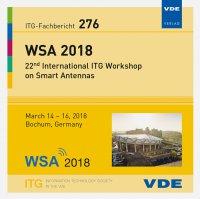Adaptive Massive MIMO for fast moving connected vehicles: It will work with Predictor Antennas!
Conference: WSA 2018 - 22nd International ITG Workshop on Smart Antennas
03/14/2018 - 03/16/2018 at Bochum, Deutschland
Proceedings: WSA 2018
Pages: 8Language: englishTyp: PDF
Personal VDE Members are entitled to a 10% discount on this title
Authors:
Phan-Huy, Dinh-Thuy (Orange Labs)
Wesemann, Stefan (Nokia Bell Labs)
Bjoersell, Joachim; Sternad, Mikael (Uppsala University)
Abstract:
Predicting the channel between a massive multiple input multiple output antenna and a car is a challenge, due to the short-term fading. It becomes essentially impossible by conventional extrapolation from past estimates if the car has moved by half a wavelength or more in space at the time when the channel estimate will be needed. This problem would prevent us from using the best fifth generation adaptive antenna downlink precoding schemes for very fast moving connected vehicles. A potential solution is to add another vehicle antenna, a “predictor antenna”, which senses the channel in advance. In this paper, based on drive tests and channel measurements from a 64- element antenna to a car, we for the first time show that this concept works for massive MIMO downlinks. Thanks to the use of a predictor antenna, the complex OFDM downlink channels can be predicted with an accuracy that enables maximum ratio transmit beamforming with close to ideal beamforming gain for non-line-of-sight channels. Zero forcing transmission to two users results in a signal-to-interference ratio of 20 dB to 30 dB when predicting non-line-of-sight channels up to three wavelengths ahead in space. These first experiment shows that the predictor antenna concept is a potential solution to make fifth generation adaptive antennas work for very fast moving connected vehicles.


